Potential Invader
carrot beetle
Family: Scarabaeidae Subfamily: Dynastinae Genus: Ligyrus Species: Ligyrus gibbosus (DeGeer, 1774)
none available
Total body length 11.6–16.5 mm (0.46–0.65 in). Body oblong. Color reddish-brown, rarely shiny black. Clypeusclypeus:
part of the head anterior to the frons; the most anterior portion in dorsal view
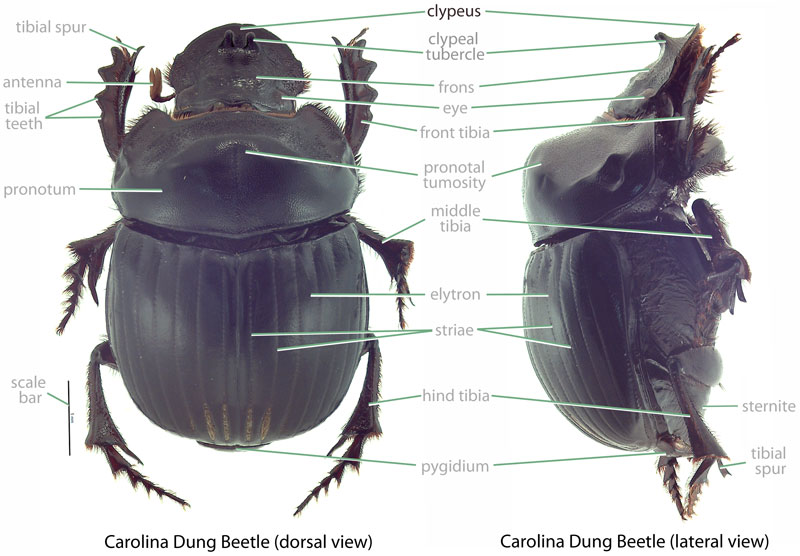 strongly constricted towards acute apexapex:
strongly constricted towards acute apexapex:
point or edge furthest from the body
; apexapex:
point or edge furthest from the body
with 2 close-set, apical teeth. Head with weak, transversetransverse:
extending horizontally across a surface
ridge on discdisc:
the central upper surface of any body part (e.g., pronotum, elytron, clypeus, frons)
; without horns or tubercles. Pronotumpronotum:
the dorsal surface of the thorax
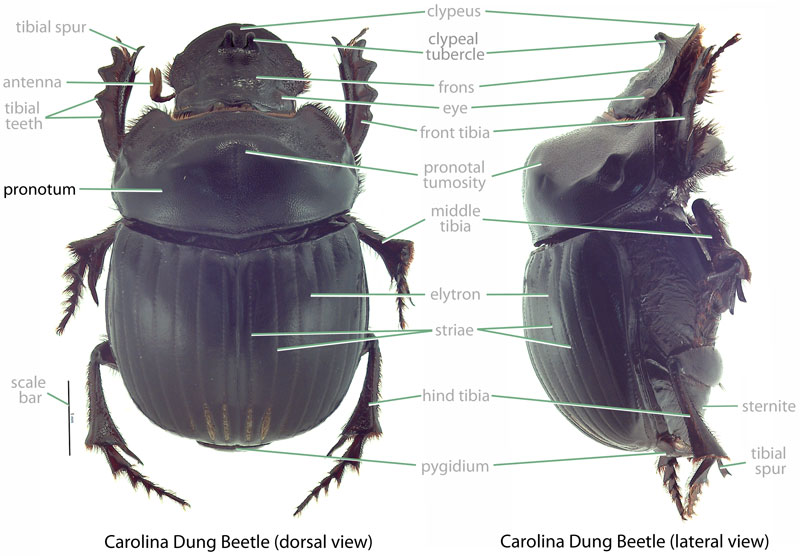 with small tubercletubercle:
with small tubercletubercle:
a small, conical knob or horn-like protuberance
near anterioranterior:
the front or forward; opposite of posterior
margin; distinct foveafovea:
a depressed pit or indentation
present behind apical tubercletubercle:
a small, conical knob or horn-like protuberance
. Apexapex:
point or edge furthest from the body
of last sternitesternite:
the ventral part of a thoracic or abdominal segment
 weakly emarginateemarginate:
weakly emarginateemarginate:
notched or with a rounded section removed from the margin, often applied to the anterior margin of the clypeus
in male, quadratequadrate:
square-like in shape
in female.
For Ligyrus spp. (Ritcher, 1966Ritcher, 1966:
Ritcher P. 1966. White grubs and their allies: a study of North American scarabaeoid larvae. Oregon State University Monographs, Studies in Entomology 4: 1-219.): Grub C-shaped, not hump-backed, cylindrical, whitish. Maxillamaxilla:
set of paired mouthparts located posterior to the mandibles
with galeagalea:
outer branch or lobe of the maxilla
 and lacinialacinia:
and lacinialacinia:
inner portion of the maxilla fused or nearly so. Lacinialacinia:
fused or nearly so. Lacinialacinia:
inner portion of the maxilla of maxillamaxilla:
of maxillamaxilla:
set of paired mouthparts located posterior to the mandibles
with 3 well developed unciunci:
in scarab larvae, a hooked process on the distal margin of the maxilla
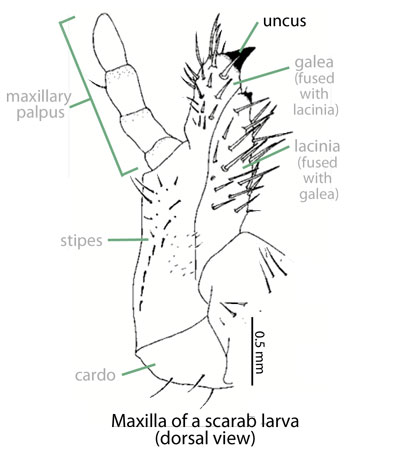 . Maxillary stridulatory teeth truncatetruncate:
. Maxillary stridulatory teeth truncatetruncate:
appearing cut-off or suddenly shortened
. Inner concave surface of mandiblemandible:
The crushing or chewing portion of an insects mouthparts
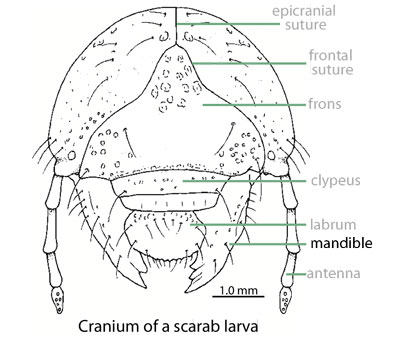 , distaddistad:
, distaddistad:
oriented away from the body or the point of articulation with body
of molar areamolar area:
grinding area of the mandible, behind scissorial area
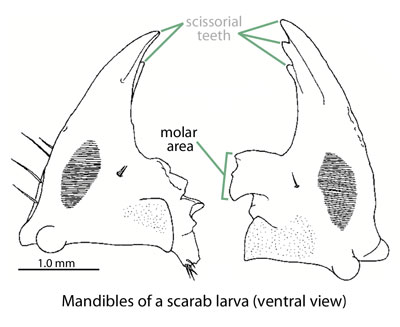 , toothed. Dorsaldorsal:
, toothed. Dorsaldorsal:
of or relating to the upper surface; opposite of ventral
surface of the last antennal segment with 2–5 sensory spots. Legs 4-segmented. Anal opening transversetransverse:
extending horizontally across a surface
, straight or slightly curved. PlegmatiaPlegmatia:
in scarab larvae, a paired, lateral region with a somewhat sclerotized surface bordered by marginal spines with acanthoparia
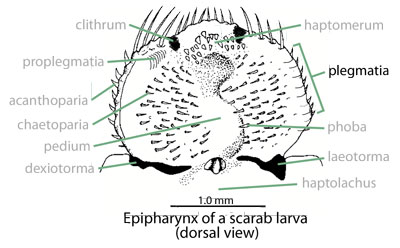 absent.
absent.
North America, southern Canada to Mexico. Ligyrus gibbosus is broadly distributed across North America from the Pacific to Atlantic coasts (Ratcliffe and Paulsen, 2008Ratcliffe and Paulsen, 2008:
Ratcliffe B and Paulsen P. 2008. The scarabaeoid beetles of Nebraska (Coleoptera: Scarabaeoidea). Bulletin of the University of Nebraska 22: 138-248.). It has been recorded in Canada (Bousquet, 1991Bousquet, 1991:
Bousquet Y (editor). 1991. Checklist of Beetles of Canada and Alaska. Agriculture Canada, Ottawa, Ontario, Canada. full text (accessed 2015)), throughout the U.S., and as far south as central Mexico (Ratcliffe et al., 2013Ratcliffe et al., 2013:
Ratcliffe B, Cave R, Cano C. 2013. The Dynastinae scarab beetles of Mexico, Guatemala, and Belize (Coleoptera: Scarabaeidae: Dynastinae). Bulletin of the University of Nebraska 27: 211-13.).
This species damages a broad range of plants as both larvalarva:
the immature form of an insect; in scarabs, also called grub or white grub; preceded by the egg stage, followed by the pupal stage
 and adult. Hayes (1917) recorded larvaelarvae:
and adult. Hayes (1917) recorded larvaelarvae:
the immature form of an insect; in scarabs, also called grub or white grub; preceded by the egg stage, followed by the pupal stage
 feeding on the roots of Amaranthus spp., domestic sunflower (Helianthus annuus), oats (Avena sativa), "pigweed" (Amaranthaceae), and wheat (Triticum spp.). Adults exhibit an even wider dietary range, including carrot (Daucus carota), celery (Apium graveolens), corn (Zea mays), cotton (Gossypium spp.), Dahlia spp., elm (Ulmus spp.), oak (Quercus spp.), sugar beet (Beta vulgaris), and sweet potato (Ipomoea batatas).
feeding on the roots of Amaranthus spp., domestic sunflower (Helianthus annuus), oats (Avena sativa), "pigweed" (Amaranthaceae), and wheat (Triticum spp.). Adults exhibit an even wider dietary range, including carrot (Daucus carota), celery (Apium graveolens), corn (Zea mays), cotton (Gossypium spp.), Dahlia spp., elm (Ulmus spp.), oak (Quercus spp.), sugar beet (Beta vulgaris), and sweet potato (Ipomoea batatas).
(Hayes, 1917Hayes, 1917:
Hayes W. 1917. Studies on the life history of Ligyrus gibbosus (Coleoptera). Journal of Economic Entomology 10: 253-261. full text (accessed 2015)): Eggs are laid in soil, 12.7–15.2 cm deep (5.0–6.0 in), at the base of a host plant. Plants in organic rich soils are preferred. In Kansas, eggs were laid May to July, larvaelarvae:
the immature form of an insect; in scarabs, also called grub or white grub; preceded by the egg stage, followed by the pupal stage
 emerging after an average of 10 days. The larval stage lasts an average of 52 days. The pre-pupal and pupal stages last an average of 7 and 19 days, respectively. Adults are most active May to June, and then again in August, suggesting that there may be multiple generations per season. Adults are nocturnal, hiding in soil during the day. Overwintering adults burrow into the soil to escape freezing.
emerging after an average of 10 days. The larval stage lasts an average of 52 days. The pre-pupal and pupal stages last an average of 7 and 19 days, respectively. Adults are most active May to June, and then again in August, suggesting that there may be multiple generations per season. Adults are nocturnal, hiding in soil during the day. Overwintering adults burrow into the soil to escape freezing.
Significant. LarvaeLarvae:
the immature form of an insect; in scarabs, also called grub or white grub; preceded by the egg stage, followed by the pupal stage
 and adults of this species damage a wide range of commercially important plants. Celery, potatoes, sugar beets, and sunflowers may be economically impacted. Sunflowers appear particularly susceptible, with both wild (Ratcliffe and Paulsen, 2008Ratcliffe and Paulsen, 2008:
and adults of this species damage a wide range of commercially important plants. Celery, potatoes, sugar beets, and sunflowers may be economically impacted. Sunflowers appear particularly susceptible, with both wild (Ratcliffe and Paulsen, 2008Ratcliffe and Paulsen, 2008:
Ratcliffe B and Paulsen P. 2008. The scarabaeoid beetles of Nebraska (Coleoptera: Scarabaeoidea). Bulletin of the University of Nebraska 22: 138-248.) and domestic (Hayes, 1917Hayes, 1917:
Hayes W. 1917. Studies on the life history of Ligyrus gibbosus (Coleoptera). Journal of Economic Entomology 10: 253-261. full text (accessed 2015)) species suffering heavy infestations.
New record, not established. We recorded a single specimen of Ligyrus gibbosus from Oahu (deposited at The Bernice Pauahi Bishop Museum). The specimen label indicates it was discovered dead in a package of dates shipped from Coachella Valley in California in 1934.
Not established or recorded. There are no records of this species from Guam.
This species is strongly attracted to lights at night and is a strong flier (Ratcliffe and Paulsen, 2008Ratcliffe and Paulsen, 2008:
Ratcliffe B and Paulsen P. 2008. The scarabaeoid beetles of Nebraska (Coleoptera: Scarabaeoidea). Bulletin of the University of Nebraska 22: 138-248.). Thus, it is likely that this beetle would be attracted to well-lit ports and airports. This would allow for hitchhiking on marine or air cargo, as likely occurred with the new record of this species in Oahu.
Although Ligyrus gibbosus is the only member of its genus recorded from Hawaii, it is similar to potential future invasiveinvasive:
a species that has recently arrived to a new location, usually via human activity, causing notable economic and/or ecological damage
species such as the sugarcane beetle (Tomarus subtropicus) and taro beetles (Papuana spp.). It can be separated from those scarabs by examination of the head that lacks horns or tubercles in L. gibbosus (Papuana spp. often possess horns or tubercles), central discdisc:
the central upper surface of any body part (e.g., pronotum, elytron, clypeus, frons)
of the head that has a weak, transversetransverse:
extending horizontally across a surface
ridge in L. gibbosus (lacking in T. subtropicus), clypealclypeal:
of, or referring to, the clypeus
apexapex:
point or edge furthest from the body
(L. gibbosus with clypeusclypeus:
part of the head anterior to the frons; the most anterior portion in dorsal view
 constricted with 2 close-set apical teeth versus clypeusclypeus:
constricted with 2 close-set apical teeth versus clypeusclypeus:
part of the head anterior to the frons; the most anterior portion in dorsal view
 broad, never with 2 close-set apical teeth as in Papuana spp.), color (T. gibbosus reddish-brown, rarely black versus Papuana spp. and T. subtropicus always shiny black), and size (T. gibbosus 11.6–16.5 mm [0.46–0.65 in] versus 15.0–25.0 mm [0.59–0.98 in] in Papuana spp. and 20.0–26.0 mm [0.79–1.02 in] in T. subtropicus).
broad, never with 2 close-set apical teeth as in Papuana spp.), color (T. gibbosus reddish-brown, rarely black versus Papuana spp. and T. subtropicus always shiny black), and size (T. gibbosus 11.6–16.5 mm [0.46–0.65 in] versus 15.0–25.0 mm [0.59–0.98 in] in Papuana spp. and 20.0–26.0 mm [0.79–1.02 in] in T. subtropicus).
Bothynus morio (LeConte), Ligyrus californicus (Casey), Ligyrus spissipes (Casey), Ligyrus arizonensis (Casey), Ligyrus bicorniculatus (Casey), Ligyrus brevipes (Casey), Ligyrus breviusculus (Casey), Ligyrus curtipennis (Casey), Ligyrus effetus (Casey), Ligyrus farctus (Casey), Ligyrus lacustris (Casey), Ligyrus laetulus (Casey), Ligyrus laevicauda (Casey), Ligyrus laticollis (Casey), Ligyrus longulus (Casey), Ligyrus lucublandus (Casey), Ligyrus parallelus (Casey), Ligyrus puncticauda (Casey), Ligyrus remotus (Casey), Ligyrus rubidus (Casey), Ligyrus scitulus (Casey), Ligyrus texanus (Casey), Ligyrus virginicus (Casey), Ligyrus laticauda (Casey), Podalgus variolosus Burmeister, Scarabaeus juvencus Fabricius, Scarabaeus gibbosus DeGeer, Tomarus gibbosus (DeGeer)
The scientific name of this species has undergone considerable change over the last several years. The genera Ligyrus and Tomarus were synonymized in 2002 (Ratcliffe, 2002) but this was challenged in a 2015 publication (Morón and Grossi, 2015).
In Hawaii, this species represents a new invasiveinvasive:
a species that has recently arrived to a new location, usually via human activity, causing notable economic and/or ecological damage
species. Prevent the spread of this species by reporting your observation at our iNaturalist project.